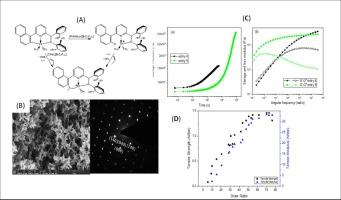Synthesis of low-entangled UHMWiPP using Hf-pyridyl amido catalyst activated by trityl tetrakis (pentafluorophenyl) borate
IF 5.8
2区 化学
Q1 POLYMER SCIENCE
引用次数: 0
Abstract
Recently we demonstrated that low entangled ultra-high molecular weight isotactic polypropylene having molecular weight up to 2.4 million g/mol can be synthesized using a Hf-pyridyl amido catalyst activated by dimethylanilinium tetrakis (pentafluorophenyl)borate. Herein, we used an aprotic borate (trityl tetrakis(pentafluorophenyl)borate) to activate a Hf-pyridyl amido catalyst leading to a fast and ease catalyst activation even at lower temperatures, thus yielding exceptionally high molecular weight (up to 7.7 million g/mol) having improved tacticity (mmmm up to 98.5 %) and peak melting temperature (up to 165 °C). Thus synthesized polymers show extremely slow equilibration process by rheological characterization, indicating the low entangled state. These polymers can be processed in solid-state, without melting, into uniaxial drawn tapes having high tensile strength (1.46 N/tex) and tensile modulus (33 N/tex). The superior mechanical properties enable the tapes to be used as reinforcing material for commercial polypropylene grades, opening the possibilities of making one-component easy-to-recycle composites.

使用由四(五氟苯基)硼酸三甲苯酯活化的 Hf 吡啶氨基催化剂合成低缠结超高分子量聚丙烯 (UHMWiPP)
最近,我们证明了使用由二甲基苯胺四(五氟苯基)硼酸盐活化的 Hf-吡啶基氨基催化剂可以合成分子量高达 240 万 g/mol 的低缠结超高分子量同向聚丙烯。在这里,我们使用一种非烷基硼酸盐(四(五氟苯基)硼酸三丁酯)来活化 Hf-吡啶氨基催化剂,即使在较低温度下也能快速、轻松地活化催化剂,从而获得分子量极高(高达 770 万 g/mol)的聚合物,其触变性(mmmm 高达 98.5%)和峰值熔化温度(高达 165 ℃)均得到改善。通过流变特性分析,合成聚合物的平衡过程极为缓慢,表明其处于低缠结状态。这些聚合物在固态下无需熔化即可加工成单轴拉伸带,具有很高的拉伸强度(1.46 N/tex)和拉伸模量(33 N/tex)。卓越的机械性能使这种带材可用作商用聚丙烯牌号的增强材料,为制造单组分易回收复合材料提供了可能。
本文章由计算机程序翻译,如有差异,请以英文原文为准。
求助全文
约1分钟内获得全文
求助全文
来源期刊

European Polymer Journal
化学-高分子科学
CiteScore
9.90
自引率
10.00%
发文量
691
审稿时长
23 days
期刊介绍:
European Polymer Journal is dedicated to publishing work on fundamental and applied polymer chemistry and macromolecular materials. The journal covers all aspects of polymer synthesis, including polymerization mechanisms and chemical functional transformations, with a focus on novel polymers and the relationships between molecular structure and polymer properties. In addition, we welcome submissions on bio-based or renewable polymers, stimuli-responsive systems and polymer bio-hybrids. European Polymer Journal also publishes research on the biomedical application of polymers, including drug delivery and regenerative medicine. The main scope is covered but not limited to the following core research areas:
Polymer synthesis and functionalization
• Novel synthetic routes for polymerization, functional modification, controlled/living polymerization and precision polymers.
Stimuli-responsive polymers
• Including shape memory and self-healing polymers.
Supramolecular polymers and self-assembly
• Molecular recognition and higher order polymer structures.
Renewable and sustainable polymers
• Bio-based, biodegradable and anti-microbial polymers and polymeric bio-nanocomposites.
Polymers at interfaces and surfaces
• Chemistry and engineering of surfaces with biological relevance, including patterning, antifouling polymers and polymers for membrane applications.
Biomedical applications and nanomedicine
• Polymers for regenerative medicine, drug delivery molecular release and gene therapy
The scope of European Polymer Journal no longer includes Polymer Physics.
 求助内容:
求助内容: 应助结果提醒方式:
应助结果提醒方式:


